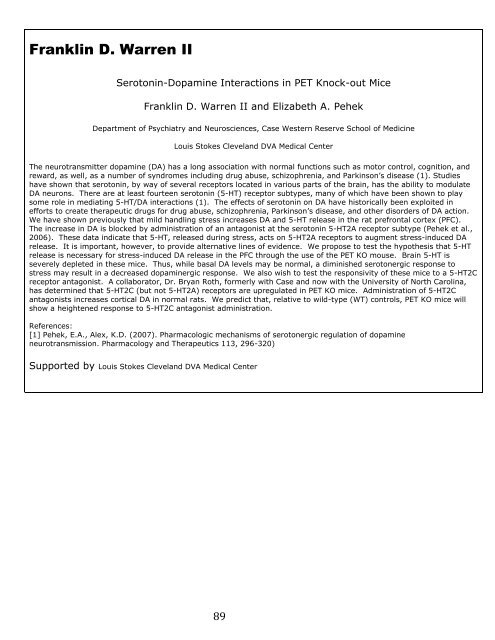student research day - Case Western Reserve University School of ...
student research day - Case Western Reserve University School of ...
student research day - Case Western Reserve University School of ...
Create successful ePaper yourself
Turn your PDF publications into a flip-book with our unique Google optimized e-Paper software.
Franklin D. Warren II<br />
Serotonin-Dopamine Interactions in PET Knock-out Mice<br />
Franklin D. Warren II and Elizabeth A. Pehek<br />
Department <strong>of</strong> Psychiatry and Neurosciences, <strong>Case</strong> <strong>Western</strong> <strong>Reserve</strong> <strong>School</strong> <strong>of</strong> Medicine<br />
Louis Stokes Cleveland DVA Medical Center<br />
The neurotransmitter dopamine (DA) has a long association with normal functions such as motor control, cognition, and<br />
reward, as well, as a number <strong>of</strong> syndromes including drug abuse, schizophrenia, and Parkinson’s disease (1). Studies<br />
have shown that serotonin, by way <strong>of</strong> several receptors located in various parts <strong>of</strong> the brain, has the ability to modulate<br />
DA neurons. There are at least fourteen serotonin (5-HT) receptor subtypes, many <strong>of</strong> which have been shown to play<br />
some role in mediating 5-HT/DA interactions (1). The effects <strong>of</strong> serotonin on DA have historically been exploited in<br />
efforts to create therapeutic drugs for drug abuse, schizophrenia, Parkinson’s disease, and other disorders <strong>of</strong> DA action.<br />
We have shown previously that mild handling stress increases DA and 5-HT release in the rat prefrontal cortex (PFC).<br />
The increase in DA is blocked by administration <strong>of</strong> an antagonist at the serotonin 5-HT2A receptor subtype (Pehek et al.,<br />
2006). These data indicate that 5-HT, released during stress, acts on 5-HT2A receptors to augment stress-induced DA<br />
release. It is important, however, to provide alternative lines <strong>of</strong> evidence. We propose to test the hypothesis that 5-HT<br />
release is necessary for stress-induced DA release in the PFC through the use <strong>of</strong> the PET KO mouse. Brain 5-HT is<br />
severely depleted in these mice. Thus, while basal DA levels may be normal, a diminished serotonergic response to<br />
stress may result in a decreased dopaminergic response. We also wish to test the responsivity <strong>of</strong> these mice to a 5-HT2C<br />
receptor antagonist. A collaborator, Dr. Bryan Roth, formerly with <strong>Case</strong> and now with the <strong>University</strong> <strong>of</strong> North Carolina,<br />
has determined that 5-HT2C (but not 5-HT2A) receptors are upregulated in PET KO mice. Administration <strong>of</strong> 5-HT2C<br />
antagonists increases cortical DA in normal rats. We predict that, relative to wild-type (WT) controls, PET KO mice will<br />
show a heightened response to 5-HT2C antagonist administration.<br />
References:<br />
[1] Pehek, E.A., Alex, K.D. (2007). Pharmacologic mechanisms <strong>of</strong> serotonergic regulation <strong>of</strong> dopamine<br />
neurotransmission. Pharmacology and Therapeutics 113, 296-320)<br />
Supported by Louis Stokes Cleveland DVA Medical Center<br />
89
















